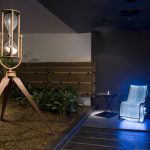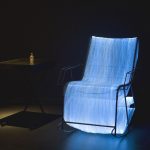- Installsion view
- U m b i l i c a l c o r d i n p e t r i d i s h
M A K I N G A H O M E: J A P A N E S E C O N T E M P O R A R Y A R T I S T S I N N E W Y O R K
Curator: Eric C. Shiner
Consultants: Sound, lighting, and software design, Andrew Schloss, Dale Stammen
optical fiber, steel, plastic chord, illuminator, sound, hourglass, petri dish, umbilical cord, gray hair
This installation is a mapping of Nagasawa’s own life narrative, producing a landscape of private memory and history between her past (origin) and present. The rocking chair is a visualization of personal body waves; her recorded heartbeat is reflected in actual light pulsations coursing through woven fiber-optic strands that comprise the rocking chair sculpture.
As visitors sit and rock, their motion drives the accelerometers, layering additional real-time light pulsations (similar to biofeedback) and modulating her body waves; representing her relationship with others whom she encounters in her life. The wave sounds are recorded from rivers of the Pacific Northwest that empty into the Pacific Ocean, the great body of water between Japan and the United States. These filaments are currently the world’s only side-light woven optical fiber. The weaving tool was invented by traditional kimono weavers and woven in Kyoto, Nagasawa’s “official home” on her birth certificate. The sound of running water represents her father’s life; he was born in Kyoto but passed away suddenly when Nagasawa turned eleven years old. The rocking chair is Nagasawa’s stake in the ground in New York, her home.
A glass table next to the chair displays corporeal specimens; Nagasawa’s own umbilical cord in a Petri dish, and a collection of her gray hair in a small medicine jar, representing her origin, and the current stage in her life. The hourglass embodies temporal repetition as history. It marks the entrance to the exhibition space, representing the role of time in the modulation and reconfiguration of cultural “integrity.” It contains sand from her mother’s hometown in Japan, and the United States, where Nagasawa lived since 1986.
As sand runs through the hourglass, the two colors mix and flow past one another, and yet individual grains remain distinct, emphasizing the individuality of the two nations—the cultures of east and west, which will never be fully assimilated but are inseparable in Nagasawa’s life. Those who turn the hourglass represent, symbolically, the many people Nagasawa encounters in her life.



